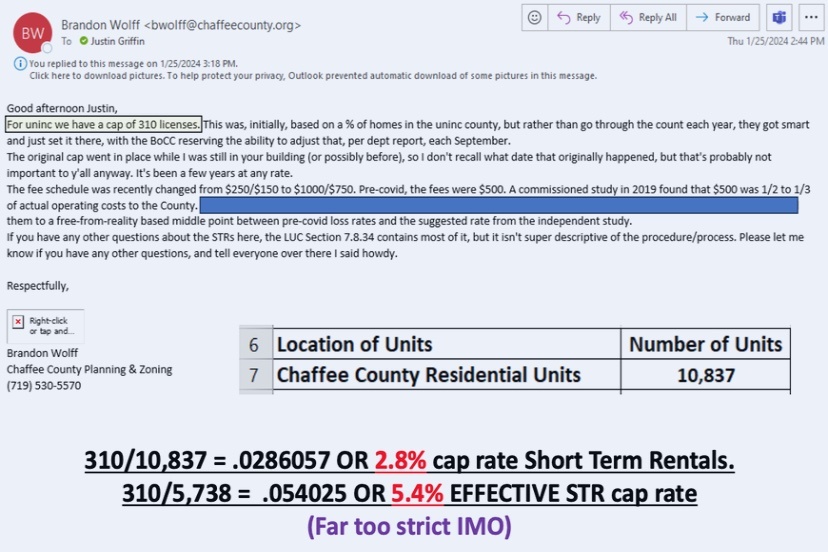As noted yesterday in Part Two, the Archuleta County Planning Commission received a presentation from County Planner Justin Griffin, who had noted an unusual fact about Pagosa Springs and Archuleta County. A huge proportion of the residential units in our community are located outside the Town limits, out in the unincorporated county.
Mr. Griffin noted that this is a very different situation from a comparable community like Chaffee County, where 47% of the homes are within the municipal limits of three separate towns.
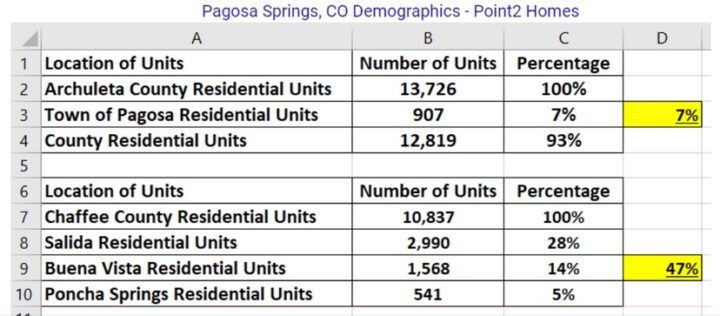
Mr. Griffin did not mention the County v. Town housing percentages in neighboring La Plata County, where the county does not have caps or density rules. (I spent some time yesterday looking for La Plata v. Durango housing data to make a comparison, but without any success.)
I mentioned yesterday that a significant portion of homes in Archuleta County are second-homes or vacation rentals. According to Mr. Griffin’s calculations, there are about 13,726 dwelling units in Archuleta County… and about 13,790 full-time residents (as of 2020). So then, approximately one dwelling unit per person.
According to my own calculations (based on an average of about 2.5 person per typical American household) this suggests that more than 50% of our homes are second-homes or vacation rentals — not occupied by full-time residents.
…Which plays into the next couple of slides that Mr. Griffin shared with the County Planning Commission:
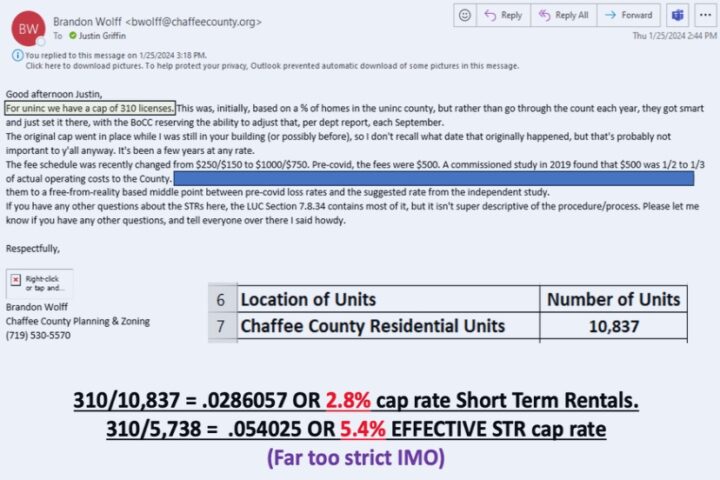
In this slide, Mr. Griffin shares an email from Brandon Wolff, with the Chaffee County Planning & Zoning Department. (Mr. Griffin told the Commission earlier that he felt Chaffee County offered a similar comparison to Archuleta County.) The email notes that Chaffee County had capped the number of allowed Short-Term Rentals (STRs) licenses at 310, and additionally had increased the fee to better cover the County’s administrative costs.
But the bold type is a calculation based on Chaffee County’s numbers. Since we’re trying to compare “county jurisdiction to county jurisdiction” rather than “community to community”, Mr. Griffin calculated the cap rate in Chaffee County at about 5.4%.
That is to say, Chaffee County appears to allow no more than 5.4% of its residential dwellings to become STRs. Once the number reaches 310, new applicants will be placed on a waiting list. Presumably.
Archuleta County regulations currently place no limit the number of STRs.
The Town of Pagosa Springs — a separate government from Archuleta County — currently caps the percentage of STRs at 10% in residential zones. The Town also requires a certain physical distance between STRs, to prevent neighborhoods from becoming commercial motel districts.
At the bottom of the slide, Mr. Griffin expresses his opinion that Chaffee County’s 5.4% “effective cap rate” is “Far too strict IMO”.
Mr. Griffin:
“We’re in a better situation, housing-wise, than Chaffee County. We have 13,726 residential units, and 13,790 people, so we basically have a house for every person. So we’re in a pretty good situation, in that regard. We don’t have a housing shortage; there’s a house per person.”
Mr. Griffin then noted that he personally shares a house with three roommates.
We seemingly have plenty of houses in Archuleta County. They just aren’t available, or affordable, for the people who live here.
Mr. Griffin continued:
“The next slide shows where we got our data…”

I personally find this slide to be quite interesting.
It appears that Mr. Griffin got a good deal of his data from a website called “Point2Homes.com”. I visited this website yesterday and looked up the information related to Archuleta County.
Point2Homes.com lists the population of Archuleta County as “21,902”.
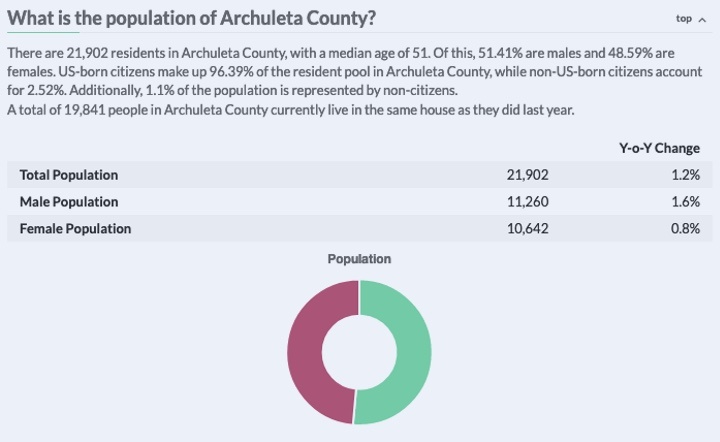
All of the other data sources I’ve found on the Internet list the population as around 14,000. Mr. Griffin uses the number “13,790” in his calculations. It would appear, in this case, that Point2Homes is sharing massively incorrect data. Maybe they know something no one else knows… that our population is actually 150% of what everyone else believes?
The next question is, of course, what other data from Point2Homes is massively incorrect? If that’s the source for Archuleta County’s data… maybe we ought to do some fact-checking?
As I pose that question, however, I will state that my own research, over the past decade, basically agrees with almost all of what Mr. Griffin told the Planning Commission on February 22.
We do not have a housing shortage in Archuleta County. We have a shortage of housing that our full-time residents can afford — especially our workforce. Those are two different aspects to the same conversation.
Mr. Griffin:
“The next slide is a map of Archuleta County, showing the Short-Term Rental units. We’ve identified 772.”
The slide included a bit of editorializing.
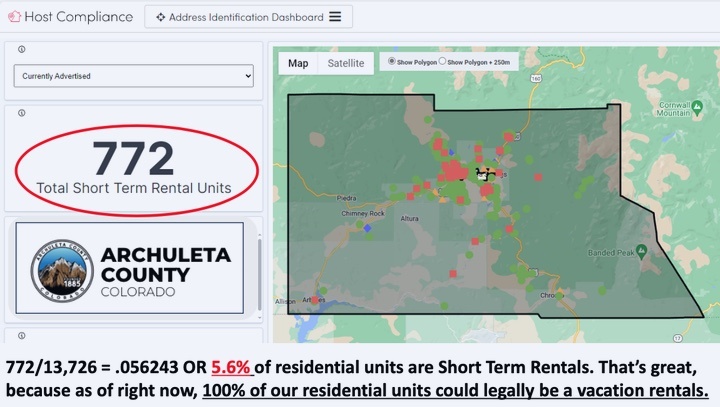
Mr. Griffin correctly notes that — currently — 100% of the residential units within the unincorporated county could legally become vacation rentals. He also estimates that — according to the County’s Host Compliance software — about 5.6% of our residential dwelling units are now STRs.
He also says, “That’s great.”
We actually don’t have any evidence that the conversion of 5.6% of our available dwelling units, into residential motels, is “great”.
Yes, it’s “great” if you consider the alternative: that 100% of the homes in the unincorporated county could legally obtain an STR permit. But we don’t know whether the mad rush by STR investors, prior to, and during, the COVID crisis, to convert Archuleta County homes into mini-motels, is partly responsible for the lack of affordable housing in our community.
We do know that housing became unaffordable during that mad rush, with a modest 2-bedroom home in Pagosa Lakes increasing from about $180,000 in 2011 to $550,000 in 2022. The following graph came from a local realtor.
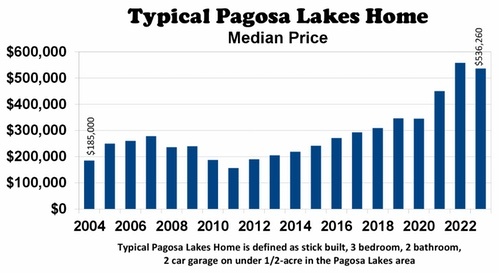
The typical monthly cost of a rental apartment or house saw a similar increase.
Those price increases may have been “great” for sellers of property, and for real estate agents, and for landlords. They were definitely not “great” for our working families and seniors on fixed incomes.

